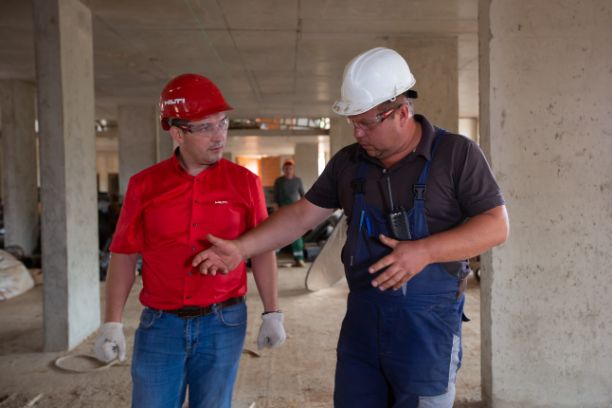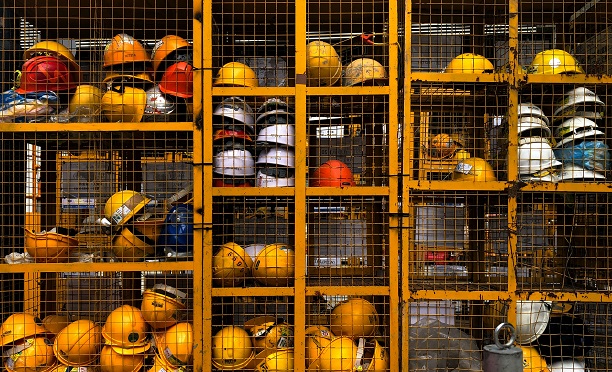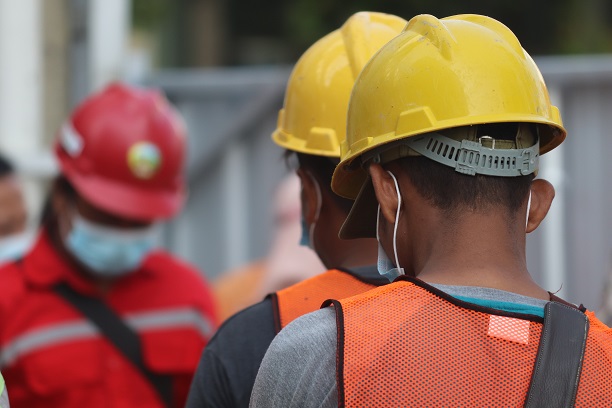Incident reporting and investigation are reactions triggered by an event. In addition to reporting and investigating the incident, statistics should be recorded and analysed to identify trends and needs.
Contents
- What Is An Incident Investigation For ISO 45001?
- Step 1: Preserve and Document the Scene
- Step 2: Collect Information
- Step 3: Determine the Root-causes
- Step 4: Implement Corrective Actions
- Step 5: Feedback to Person(s) Reporting the Incident
- Incident Reporting & Investigation Procedure [Template download]

Employers have a legal obligation and a workers’ compensation insurance requirement to ensure incident reports and investigations are completed. Incident reporting and investigation contribute to the corporate memory.
These memories demonstrate failures in existing systems and assist in learning from these failures so we can prevent similar or worse loss in future.
Our Incident Reporting & Investigation Procedure is proven to work.
The trending reports that are produced from investigating and reporting incidents can be used to identify deficiencies in the system so that corrections and improvements can be made.
This clause states the requirements for the occurrence of an incident or nonconformity. The requirements also include action to prevent a similar incidents or nonconformities occurring. This must be achieved via review and analysis to determine what caused it, and any actions to prevent it re-occurring in the future.
Analysis of incident reports suggests that many incidents are related to breakdowns in areas such as training, competence, planning and implementation of tasks, maintenance of equipment etc.
The organisation needs to put in place systems which enable the capture and evaluation of non-harm events, so that appropriate corrective and preventive actions might be implemented, which either prevent occurrence or recurrence of the events.
There needs to be robust systems in place to ensure that incidents are adequately investigated and appropriate lessons are learned.
ISO 45001 requires your organization to put in place procedures to respond to health and safety related nonconformities.
The definitions given in ISO 45001 are helpful in understanding the differences in terms, but put simply, this clause addresses the need to manage things that either could have gone wrong or actually have gone wrong.
The procedures need to ensure that proper control is exercised over the reporting and investigation of incidents, incidents and nonconformances, that any immediate actions are put in place, and that any longer-term corrective, or even preventive, actions are initiated and completed.
The procedures need to define responsibilities for those involved at all stages of the process.
The system needs to take account of injury or damage to employees, visitors, contractors and members of the public, as well as looking at property damage. There needs to be a thorough investigation of all incidents, so that the root-causes of the problem may be properly understood.
Data needs to be gathered and records maintained of all stages in the investigation process. It is vital that relevant corrective action be put in place to address problem that have arisen. This action should be reviewed through the risk assessment process prior to implementation; after all, the intention is not to make an unsafe situation worse!

It is vital that unsafe situations are made safe as soon as practicable, which means that corrective action may take place in a number of phases with immediate action to prevent further harm, and medium or longer-term action, dependent on the programme needed, to prevent recurrence of the issue.
A formal system to implement preventive actions is also needed, using data gathered during audit and safety tours, or associated with changes of materials, processes or equipment etc. Again, proper records need to be taken of any preventive actions put into place, and they should of course have been subject to risk assessment.
Our Incident Reporting & Investigation Procedure is proven to work.
All nonconformances need to be classified and analysed on a regular basis, so that the organisation may understand how effective the health and safety management system is proving to be. The analysis should include such things as incidents, injuries, lost time, ill-health absence, absenteeism, types of damage etc.
The results of the analysis need to be communicated to all relevant interested parties. This is particularly the case where the organisation is active at a number of sites or in a number of countries, where the spreading of ‘learning opportunities’ may be more difficult.
Implementing a systems approach will help ensure all incident investigations are successful.

Preserve the scene to prevent material evidence from being removed or altered; investigators can use cones, tape, and/or guards. Document the scene by documenting the incident facts such as the date of the investigation and who is investigating.
Essential to documenting the scene is capturing the injured employee’s name, injury description, whether they are temporary or permanent, and the date and location of the incident. Investigators can also document the scene by video recording, photographing and sketching.
Incident information is collected through interviews, document reviews and other means.
In addition to interviews, investigators may find other sources of useful information. These include:

Interviews can often yield detailed, useful information about an incident. Since memories fade, interviews must be conducted as promptly as possible: preferably as soon as things have settled down a bit and the site is both secure and safe.
The sooner a witness is interviewed, the more accurate and candid his/her statement will be.
An incident investigation always involves interviewing and possibly re‐interviewing some of the same or new witnesses as more information becomes available, up to and including the highest levels of management. Carefully question witnesses to solicit as much information as possible related to the incident.
Since some questions will need to be designed around the interviewee, each interview will be a unique experience.
When interviewing injured workers and witnesses it is crucial to reduce their possible fear and anxiety, and to develop a good rapport.
When conducting interviews, investigators should:

The root-causes of an incident are exactly what the term implies: The underlying reasons why the incident occurred in a workplace. Root-causes generally reflect management, design, planning, organizational and/or operational failings (e.g.; employees were not trained adequately; a damaged guard had not been repaired).
Finding the root-causes goes beyond the obvious proximate or immediate factors; it is a deeper evaluation of the incident. This requires persistent “digging”, typically by asking “Why” repeatedly. Conclusions such as “worker was careless” or “employee did not follow safety procedures” don’t get at the root-causes of the incident. To avoid these incomplete and misleading conclusions in the investigative process, investigators need to continue to ask “why?” as in, “Why did the employee not follow safety procedures?”.
If the answer is “the employee was in a hurry to complete the task and the safety procedures slowed down the work”, then ask “Why was the employee in a hurry?” The more and deeper “why?” questions asked, the more contributing factors are discovered and the closer the investigator gets to the root-causes. If a procedure or safety rule was not followed, why was the procedure or rule not followed?
Did production pressures play a role, and, if so, why were production pressures permitted to jeopardize safety? Was the procedure out‐of‐date or safety training inadequate? If so, why had the problem not been previously identified, or, if it had been identified, why had it not been addressed?
It cannot be stressed enough that a successful incident investigation must always focus on discovering the root-causes. Investigations are not effective if they are focused on finding fault or blame. If an investigation is focused on finding fault, it will always stop short of discovering the root-causes, because it will stop at the initial incident without discovering their underlying causes.
The main goal must always be to understand how and why the existing barriers against the hazards failed or proved insufficient, not to find someone to blame.
Investigator Example Questions
The questions listed below are examples of inquiries that an investigator may pursue to identify contributing factors that, in turn, can lead to root-causes:
- If a procedure or safety rule was not followed, why was the procedure or rule not followed?
- Was the procedure out of date or safety training inadequate?
- Was there anything encouraging deviation from job procedures such as incentives or speed of completion? If so, why had the problem not been identified or addressed before?
- Was the machinery or equipment damaged or fail to operate properly? If so, why?
- Was a hazardous condition a contributing factor? If so, why was it present? (e.g.; defects in equipment/tools/materials, unsafe condition previously identified but not corrected, inadequate equipment inspections, incorrect equipment used or provided, improper substitute equipment used, poor design or quality of work environment or equipment)
- Was the location of equipment/materials/worker(s) a contributing factor? If so, why? (e.g.; employee not supposed to be there, insufficient workspace, “error‐prone” procedures or workspace design)
- Was lack of personal protective equipment (PPE) or emergency equipment a contributing factor? If so, why? (e.g.; PPE incorrectly specified for job/task, inadequate PPE, PPE not used at all or used incorrectly, emergency equipment not specified, available, properly used, or did not function as intended)
- Was a management programme defect a contributing factor? If so, why? (e.g.; a culture of improvisation to sustain production goals, failure of supervisor to detect or report hazardous condition or deviation from job procedure, supervisor accountability not understood, supervisor or worker inadequately trained, failures to initiate corrective actions recommended earlier)
Accidents/incidents are seldom caused by a single human error or technical failure. They are mostly a result of series of failures in different parts of multiple systems. Therefore, you may need to conduct an internal incident investigation (including visiting the scene, conducting interviews, taking phones, and checking records, etc.) to improve understanding of the events leading up to the incident.

The investigation is not complete until corrective actions are implemented that address the root-causes of the incident. Implementation should entail programme level improvements and should be supported by senior management.
Note that corrective actions may be of limited preventive value if they do not address the root-causes of the incident. Throughout the workplace, the findings and how they are presented will shape perceptions and subsequent corrective actions. Superficial conclusions such as "He/she should have used common sense," and weak corrective actions such as “Employees must remember to wear PPE”, are unlikely to improve the safety culture or to prevent future incidents.
In planning corrective actions and how best to implement them, employers may find that some root-causes will take time and perseverance to fix. Persisting in implementing substantive corrective actions, however, will not only reduce the risk of future incidents but also improve the company’s safety, morale and its bottom line.
Specific corrective actions address root-causes directly; however, some corrective actions can be general, across‐the‐board improvements to the workplace safety environment.
Sample global corrective actions to consider are:
Our Incident Reporting & Investigation Procedure is proven to work.

Upon completion of the investigation, a closing meeting should be scheduled between the investigation team and the parties responsible for implementing recommendations. All parties should commit themselves to respect the results of the investigation and to develop a corrective action plan in response to the findings.
Corrective action plans should be documented in a way that allows for accountability and future follow-up. To build up and maintain employees’ confidence in reporting incidents, ways should be established for employees to follow up to find out what actions are taken as a result of their reports.
Feedback to employees is even more important when no action is taken, because in the absence of any visible action and follow-up, employees will come to see less meaning in reporting incidents and eventually will stop reporting them.
For anonymous reports, this feedback may be circulated in the form of a notice board, a message on the company intranet or an e-mail to all employees containing a brief statement of the reported issue and action(s) taken based on the report, or the reason(s) why no action needs to be taken. Review of Hazard and Incident Reports by the OH&S Committee.
All of the ISO 45001 clauses are fully-documented and explained in our Occupational Health and Safety Management System Template (OH&S).
We have procedures, templates, checklists, process maps, forms and gap analysis tools to help your documentation without missing a single input or output.
Before you invest all the hours reinventing the wheel, before you spend countless dollars outsourcing the task — try our templates.
Updated: 6th May 2022
Author: Richard Keen

Richard is our Compliance Director, responsible for content & product development.
But most importantly he is ISO's biggest fanboy and a true evangelist of the standards.
Learn more about Richard

Don’t Try to Manage It All Alone!
Our ISO Auditors and OH&S Trainers have been in this industry for years, and since 2002 we’ve been providing thousands of small businesses and large corporations with the tools they need to get certified.
Instead of trying to create everything you need to follow this process from scratch, use ours. We have procedures, templates, checklists, process maps, forms and gap analysis tools to help you control your documented information without missing a single input or output.
Before you invest all the hours reinventing the wheel, before you spend countless dollars outsourcing the task — try our templates.
| QMS ISO 9001 |
EMS ISO 14001 |
OH&S ISO 45001 |
|
|
Incident Reporting & Investigation Procedure The purpose of this procedure is to outline your organization’s methodology to establishing the processes required for an effective incident and near miss response programme which methodically examines all undesired events that have or could have resulted in physical harm to interested parties or result in damage to property. The intent of any resulting investigation is to establish the facts and circumstances related to the event in order to determine the root-cause and develop remedial action to control the risk.
Forms & Reports also included:
>> Free Download - Control of Calibrated Equipment Procedure - this will give you a good idea of what to expect when you purchase the procedure. |
$19 USD |
Pay by Credit Card, Debit Card, PayPal or Apple Pay.

 |
Please read our Money Back Guarantee. |
Bought by Small Businesses and Large Corporations our templates have been sold online and CD since 2002.
Used by:
The Templates are used by first-timers following our step-by-step, clause-by-clause guidance documents; and experienced Quality Managers wishing to streamline and improve their existing documentation.
The application of our templates and OH&S manuals is scalable and generic; regardless of the size and type of organization. The elements that form the Health and Safety Management System Template are the same.
1. Our customizable templates save you time and money by offering a streamlined process to create your quality documentation
2. They’ve got everything you need in one simple template
3. Proven to work our templates have helped thousands of businesses big and small achieve certification
4. Documents use styles to make reformatting and rebranding a breeze
5. Our templates are generalizable for any industry or sector. The application of our templates is scalable and generic; regardless of the size and type of organization.